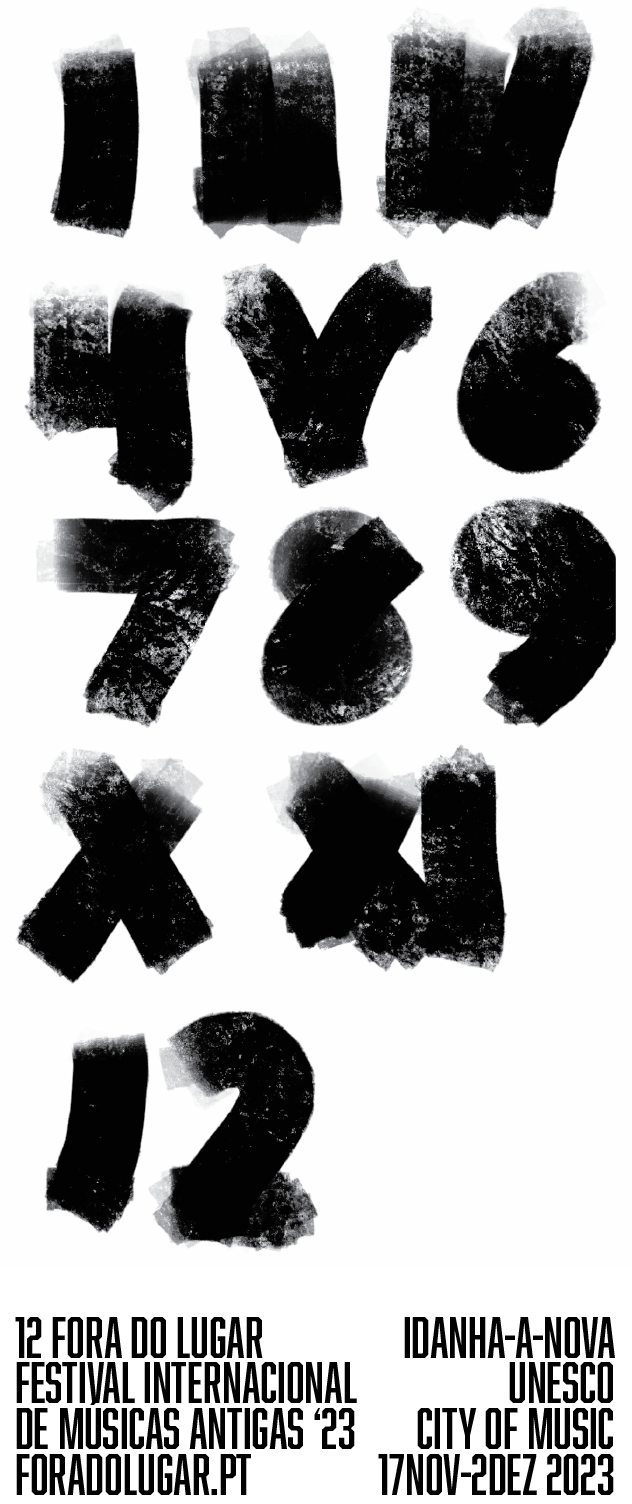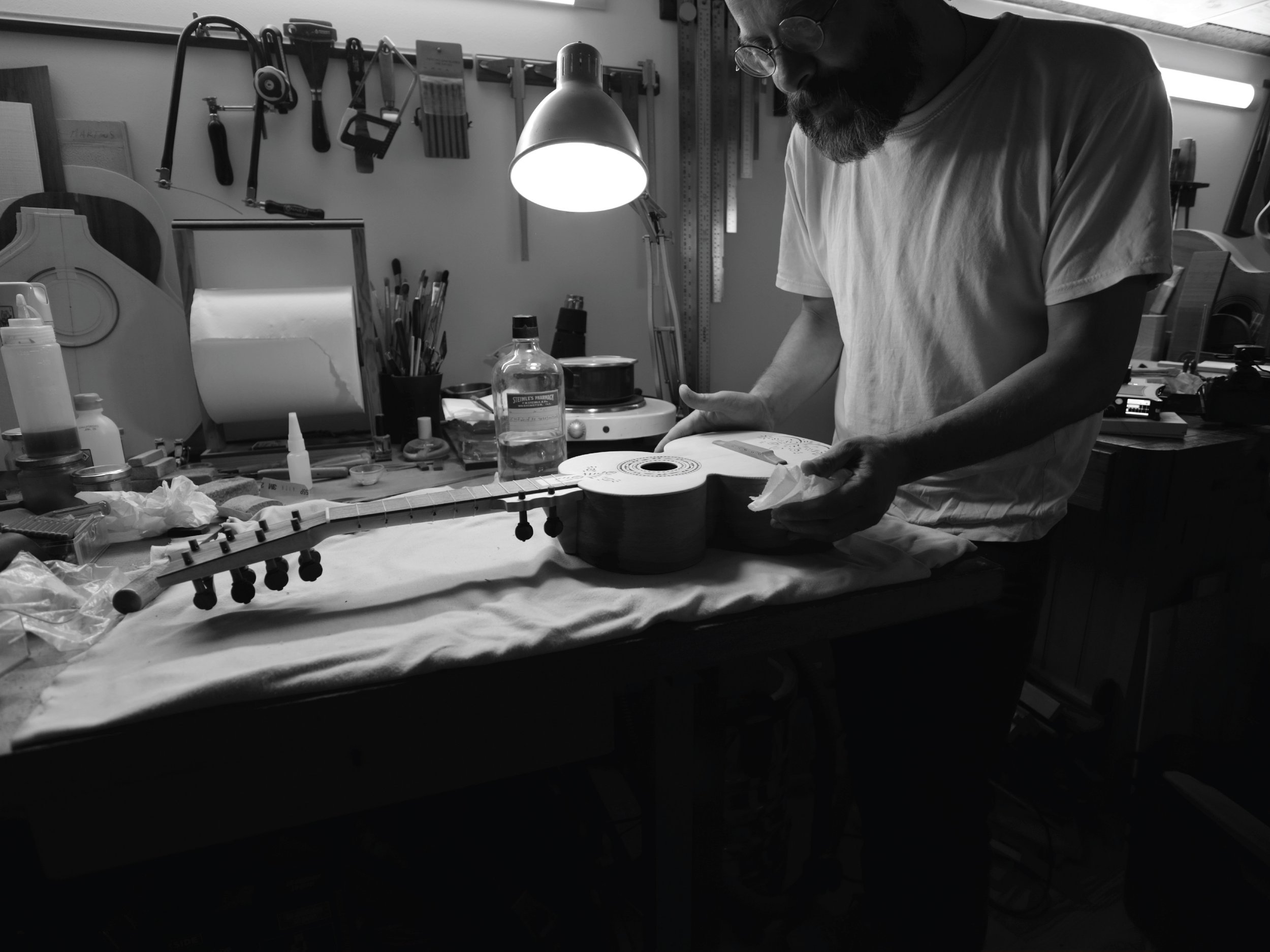Noite Cheia
Full Night
Projecto
Project
24.11.2023
20h00-23h00 #2
Na matéria do diálogo
IDANHA-A-NOVA
CENTRO CULTURAL RAIANO
NOITE CHEIA FULL NIGHT
#1 Exposição Exhibition: Guardados 001
#2 Projecto Project: Na matéria do diálogo
#3 Concerto Concert: Mashrabyia
#4 Gastronomia Gastronomy: Tertúlia com sopa Social gathering with soup
#5 Cinema Film: DocLisboa: Extensão Fora do Lugar DocLisboa: Fora do Lugar Extension
Projecto: Na matéria do diálogo
Reinterpretação da Viola Beiroa de
Manuel Moreira (Salvador, 1891-1970), Penha Garcia
Um diálogo com a viola de mão de Belchior Dias (Lisboa, 1581).
Project: On the subject of dialogue
Reinterpretation of Manuel Moreira's
Viola Beiroa (Salvador, 1891-1970), Penha Garcia
A dialogue with Belchior Dias' renaissance guitar (Lisbon, 1581).
Que não acorde ninguém Excerpt
Filipe Faria
A tapeçaria bordada pelos elementos do património musical português é um reflexo do cruzamento de fios culturais e históricos que moldaram a identidade musical do país ao longo dos séculos. O nosso instrumentário musical popular, tal como o conhecemos hoje, é o resultado da contaminação inevitável de viagens, gostos pessoais, experiências individuais ou necessidades colectivas. A evolução é inevitável — hoje não tenho aquela madeira, amanhã consigo outra, hoje pedem-me que crie novas formas, aumente, diminua, amanhã que crie algo novo, que copie o passado, hoje que mantenha fielmente o desenho e as cores, amanhã que arrisque novas combinações.
Os instrumentos têm esta capacidade… são, ao mesmo tempo, ferramenta e obra de arte, representam, ao mesmo tempo, pessoas, colectividades, regiões, países, continentes… Vividos no passado, continuam a ecoar na experiência musical dos dias de hoje, contribuindo para a riqueza da memória sonora colectiva.
A música, como forma de expressão universal, não conhece fronteiras geográficas… é invisível, sem limites. Na sua expressão física nunca teve dificuldade em entrar pelas portas e janelas, ajudada por caminhantes e bagagens, barcos, caravelas, comboios ou aviões. Esta viagem cria novos cruzamentos e sugere, ainda, outros caminhos… a contaminação (inevitável) traz uma nova dimensão ao nosso instrumentário. (...)
Dos ramos de várias árvores Excerpt
Orlando Trindade
Tudo começou com um telefonema do Filipe Faria propondo-me a construção de duas violas: uma viola de quatro ordens renascentista e uma reinterpretação de uma viola popular, neste caso a Beiroa. Desde logo achei que a viola renascentista teria de partir do exemplar mais antigo que chegou até nós, e que se encontra actualmente no museu dos instrumentos musicais do Royal College of Music, em Londres, em cuja etiqueta se pode ler: «Belchior Dias a fez em Lisboa no mês de Dezembro de 1581». Para além de ser portuguesa, e a mais antiga que se conhece, tem também a raríssima característica de ter o fundo composto por sete aduelas dobradas em meia cana e arqueadas longitudinalmente, uma técnica elaborada e virtuosa que aparece referida em alguns documentos, como num texto de 1638 no qual se diz que Manuel de Vega fez uma guitarra de tamanho médio com o fundo canelado feito de ébano de Portugal, «hevano de Portugal… el suelo tumbado e acanelado…»
Em relação à viola Beiroa, iríamos partir das violas mais antigas sobreviventes, dando especial ênfase e importância ao instrumento que pertenceu a Manuel Moreira de Penha Garcia e que se encontra actualmente no Museu Nacional de Etnologia em Lisboa. (...)
Na matéria do diálogo Excerpt
Paulo Longo
Os princípios da intervenção cultural do Município de Idanha-a-Nova são matéria de reflexão, discussão, reconhecimento e desacordo, permanentes.
E ainda bem que assim é. A qualquer estratégia de desenvolvimento que se quer transversal e diversa, seja em que área for – e, decididamente, na cultura – o diálogo, sob as suas múltiplas formas, é ferramenta essencial para aferir o grau de dinamismo presente nesse território. Para o bom, e o menos bom. O consenso generalizado não é, necessariamente, o melhor sinal neste domínio – como também não o é, certamente, a ruptura irredutível – pois ambas deixam de lado o diálogo entre as partes que têm de projectar e construir futuros.
Hoje, como ontem, o processo que medeia tradição e renovação constrói-se, precisamente, na matéria do diálogo, entre legado e visão, num processo exigente e moroso. A ausência de riscos é pura ilusão e não há como contorná-lo – ainda assim, é preferível corrê-los do que não o fazer de todo e ficar escondidos na paz podre do indiscutível ou do inquestionável.
Esta percepção afigura-se singularmente pertinente no domínio que nos traz aqui. Se há algo que podemos – e devemos - aprender nas propostas desenvolvidas sob a direcção de Filipe Faria, é que vale a pena arriscar, com coragem e responsabilidade, sem fechar futuros à chave. (...)
Reviver e reinterpretar os caminhos da herança musical Excerpt
João Soeiro de Carvalho
O mote desta publicação levou-me a refletir brevemente sobre as experiências de intervenção no domínio das práticas musicais associadas ao conceito de património musical, e sobre as suas bases teóricas e fundamentos intelectuais. Trata-se de um assunto de grande relevância contemporânea, na medida em que tem vindo crescentemente a fazer parte do universo da música em muitos locais, inicialmente na Europa e Estados Unidos da América, e hoje um pouco por todo o mundo. (...)
A música está no cruzamento de muitas experiências culturais diferentes. Constitui um cadinho de investigação onde se combinam o fascínio pelo património musical e a exploração de novas vias criativas. Preserva as marcas das culturas, representando os seus traços idiomáticos que vibram com os seus próprios dispositivos sonoros, com instrumentos que são erguidos como emblemas, tais como a bandurra. É preciso, antes de mais, criar uma perspectiva, uma experiência efectiva, para que as pessoas compreendam o valor das suas próprias linguagens musicais idiossincráticas. Mas sem negar esta herança, os músicos parecem estar conscientes e determinados a utilizar uma linguagem original, individual e contemporânea.
That which won't wake anyone up Excerpt
Filipe Faria
The tapestry embroidered by the elements of Portugal's musical heritage is a reflection of intersecting cultural and historical threads that over the centuries have moulded the country's musical identity. Our folk musical instruments, as we know them today, are the result of the inevitable contamination of travels, personal tastes, individual experiences, and collective needs. Evolution is inevitable — I don't have that type of wood today, tomorrow I'll get a different one, today they ask me to create new forms, bigger, smaller, tomorrow they will ask me to create something new, to copy something from the past, to faithfully maintain design and colours, to develop new combinations.
Instruments have this ability. They are both a tool and a work of art. They represent people, communities, regions, countries, continents. Having lived in the past, they continue to echo in today's musical experience, contributing to the richness of the collective sonic memory.
Music, as a universal form of expression, knows no geographical boundaries. It is invisible and has no limits. In its physical expression, it has never found it difficult to enter through doors and windows, aided by walkers and luggage, boats, caravels, trains or aeroplanes. This journey creates new crossings and suggests new paths. The (inevitable) contamination brings a new dimension to our instrumentation. (...)
From the branches of various trees Excerpt
Orlando Trindade
It all started with a phone call from Filipe Faria proposing that I build two guitars: a Renaissance guitar with four courses of strings and a reinterpretation of a popular viola beiroa. I immediately thought that the Renaissance guitar would have to be based on the oldest example that has come down to us, which is currently held in the museum of musical instruments at the Royal College of Music in London, the label of which reads: 'Made by Belchior Dias in Lisbon in December 1581.' As well as being Portuguese, and the oldest known, it has the very rare characteristic of having a back made up of seven perpendicularly curved staves that are arched longitudinally, an elaborate and virtuosic technique that is mentioned in some documents, including a text from 1638 in which Manuel de Vega is said to have made a medium-sized guitar with a fluted back made of ebony from Portugal, 'hevano de Portugal… el suelo tumbado e acanelado...'
For the viola beiroa, we would start with the oldest surviving guitars from the Beiras region, placing special emphasis and importance on the instrument that belonged to Manuel Moreira from Penha Garcia, currently in the National Museum of Ethnology in Lisbon. (...)
On the subject of dialogue Excerpt
Paulo Longo
The principles of cultural intervention by the Municipality of Idanha-a-Nova are a matter of constant reflection, discussion, recognition and disagreement.
And that's a good thing. For any development strategy that wants to be transversal and diverse, in any area – and most definitely in culture – dialogue, in its many forms, is an essential tool for gauging the degree of dynamism present in a territory. For the good, and for the not so good. General consensus is not necessarily the best sign in this regard – though neither is an unbridgeable rupture – because both neglect dialogue between parties that have to plan and build futures together.
Today, as in the past, the demanding and time-consuming process that mediates tradition and renewal is built precisely on dialogue, between legacy and vision. The absence of risk is an illusion – there's no way around it – yet even so, it's better to take risks than to do nothing at all and remain mired in the decaying tranquillity of the indisputable or the unquestionable.
This insight seems uniquely pertinent in the field that concerns us here. If there's one thing we can and should learn from the proposals developed under Filipe Faria's direction, it's that it's worth taking risks, with courage and responsibility, without locking futures away. (…)
Reviving and reinterpreting the paths of musical heritage Excerpt
João Soeiro de Carvalho
The motto of this publication led me to reflect briefly on my experiences intervening in the field of musical practices associated with the concept of musical heritage, and on its theoretical bases and intellectual foundations. This is a subject of great contemporary relevance, having increasingly become part of the world of music in many places, initially in Europe and the United States of America, and now all over the world. (…)
Music is positioned at the crossroads of many different cultural experiences. It is a crucible of research where fascination with musical heritage and exploration of new creative avenues meld together. It preserves the marks of cultures, representing their idiomatic traits that vibrate with their own sound devices, with instruments that are raised as emblems, such as the Bandurra. First and foremost, we need to create a perspective, an effective experience, so that people realise the value of their own idiosyncratic musical languages. Musicians seem to be aware of and determined to use an original, individual and contemporary language without denying this heritage.


